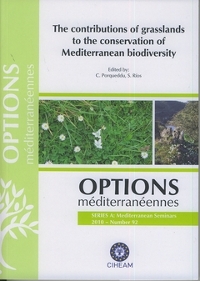| Article précédent | p. 175-179 | Article suivant |
Some expected climatic changes impacts on the pasture and forage species in Morocco
In Morocco, many grazed areas, such as rangelands, forage cultivated areas and fallows, constitute the most important feed resources for livestock. However, in last year's, climatic factors such as drought, have affected the availability of forage production in quantity and quality. Drought is the major climatic change factor affecting the growth of cultivated forages and the survival and regeneration of many pasture species growing in rangeland areas. Thus, in rainfed areas, forage cropping system will change progressively according to each crop water requirements. In the irrigated area, alfalfa, a water consumer crop will be probably replaced by some less water consumer crop, and the summer production crop will be banished due the high temperatures and water scarcity. The spontaneous forage species will be much more affected by biodiversity reduction. Perennial grasses and legumes which are the forage species most appreciated by animals are also the most threatened. According to their agro-physiological needs, these species will suffer differently from the climatic changes. However, until now, there is no study on how the climatic changes will affect these two major groups of species or predicting their evolution. We will present some hypothesis to predict the expected effects of climatic changes on some forage and pasture species. Some issues for research to improve plant resilience will be discussed.
Au Maroc les ressources fourragères proviennent des parcours, de la sole fourragère et des jachères. Cependant, des facteurs climatiques tels que la sécheresse, ont largement influencé la disponibilité fourragère tant en quantité qu'en qualité. La sécheresse est le principal facteur de changement climatique affectant la croissance des fourrages cultivés, la survie et la régénération de plusieurs espèces pastorales au niveau des parcours. Ainsi, dans les zones pluviales, il faudrait s'attendre à un changement des systèmes de culture fourragers selon les besoins de chaque espèce. Dans les zones irriguées, la luzerne, culture consommatrice d'eau, serait probablement remplacée par d'autres cultures moins exigeantes en eau et la production fourragère estivale risque d'être bannie à cause des hautes températures. Les espèces spontanées seraient plus affectées par l'appauvrissement en biodiversité, parmi lesquelles les graminées et les légumineuses seraient les plus affectées. Cependant, à l'heure actuelle, il n'y a pas eu d'études spécifiques et précises sur les impacts possibles et probables des changements climatiques sur la production des espèces fourragères et pastorales au Maroc. C'est pourquoi, nous nous sommes limités dans cet article à la formulation d'hypothèses sur la base des rares données disponibles.
- [ Afficher ]
- [ Télécharger ]
- [ Exporter la citation ]
Vous pouvez télécharger la citation au format :
- [ Imprimer ]
-
Mots-clés
ADAPTATION, CHANGEMENT CLIMATIQUE, MAROC, PATURAGES, PLANTE FOURRAGERE, SECHERESSECiter cet article
Al Faïz C., Thami Alami I., Moussadek R., El Oumri M. Some expected climatic changes impacts on the pasture and forage species in Morocco. In : Porqueddu C. (ed.), Ríos S. (ed.). The contributions of grasslands to the conservation of Mediterranean biodiversity. Zaragoza : CIHEAM / CIBIO / FAO / SEEP, 2010. p. 175-179. (Options Méditerranéennes : Série A. Séminaires Méditerranéens; n. 92). 13. Meeting of the Sub-Network on Mediterranean Forage Resources of the FAO-CIHEAM International Network for the Research and Development of Pasture and Forage Crops, 2010/04/07-10, Alicante (Spain). http://om.ciheam.org/om/pdf/a92/00801238.pdf



